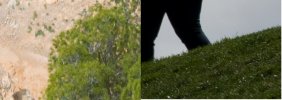There are 48M real photosites, but the sensor does not capture an RGB triplet of values. Rather, each element captures red, green, or blue, and the other two values for that pixel are interpolated from neighbors via a mathematical process called demosaicing.
We actually don't know that. The specifications say "Effective Pixels: 48MP", the actual number of photosites whould have to be much larger.
What follows is just my own technical musings with the goal to improving understand for myself and others.
So, some definitions are in order.
Photosite: a single light sensing element that responds only to light intensity (not color). To represent color it takes 3 photosites, each with a color filter. 3 photosites are combined using a demosaicing algorithm that combines the 3 sensors into one color pixel.
Pixel: The smallest element of a raster (grid) image. A pixel can contain color data or just intensity. The images we deal with from digital cameras have pixels with color data.
Effective Pixels: This is a means of stating how many pixels (color) actively contribute to the final image. There are some pixels that are outside the active image area that do not contribute to the image directly but may be used in calibration. These are not typically counted as "effective" pixels.
Total Pixels: A statement of the total number of pixels available on a sensor, usually a larger number than the "effective" pixels, though often the two numbers are very close.
Image sensor size: Stated in inch-related measurements, and refers to a 1" video camera tube's physical diameter. So a 1" sensor is the equivalent of the image sensing area of a 1" diameter video camera tube, but there is no dimension of that sensor that is actually 1 inch! The size of a "1 inch" sensor is actually more like 16mm diagonal. The chart below comes from
Commonlands.com.
The number of pixels in a given sensor size directly relates to how many photons a photosite can capture. There's no real magic here. A lot of photosites in a small area capture fewer photons individually, and the result is more noise in low light conditions, and fewer photosites in the same area, are larger and capture more photons, with the result being a higher signal to noise ratio.
Based on physics alone, the camera in the
Mini 3 Pro should produce worse low light images than the camera in an
Air 2S. But it doesn't, so something else is going on.
One clue comes from closely examining (enlarging) a DNG image file. Weather has turned against me, so I couldn't shoot my own, and these are found online.
So...two images, the left from a
Mini 3 Pro 48MP DWG file, the right from a Canon 5DIV raw file.

Original image files are here:
5D IV image
M3P image
These sensors are nothing alike. The 5D IV has a 30.4 Megapixel full-frame CMOS sensor measuring about 43mm diagonal, the
M3P has "effective pixels" at 48MP (more than the 5d), but with a sensor size somewhere around 9mm diagonal. That means the photosites and resulting color pixels are much larger in the 5D, but the total number of pixels is significantly lower than the
M3P.
But that's not just what's going on. Look closely at the results of image processing.
Both samples are enlarged 800%. There are clearly more pixels in the
M3P image, but processing has blobbed them together obliterating the fine detail. No matter how much blow-up is used, the 5D image always has better detail, and fewer pixels.
It's just a theory at this point, but it may be possible that some form of smart pixel clustering is being used to greatly improve the signal to noise ratio in the
M3P image at the expense of true 48MP detail. This would make sense. There was a need for a smaller camera for the
M3P, but DJI would certainly want to improve its performance in every way. That means more, but smaller pixels. Smaller pixels require more noise reduction. There's probably a sweet spot where noise can still be effectively processed out, but resolution is still high enough to look good.
I hope nobody gets the wrong idea here, I'm not really trying to compare a tiny drone camera to a full frame DSLR, that's not the point. The goal is to try to decifer what DJI is doing to make a smaller sensor with even smaller photosites appear to work better than it should.
Philosophically, it's always about the right tool for the job. Drone cameras are no exception. We'd all like to see a little sub 250g aircraft have all the features we could ever want, but that's not practical. It does quite well for its size, and beats larger aircraft in some ways, not in others, beats smaller aircraft in many ways, not in all. It's a work in progress, so our complaining is partly justified, but also the product of impatience. I like it, I fly it a lot....and I like my
Air 2S too...and I'd like to own the top-end
Mavic 3 too. But I also know that as good as that might be, for photograph and video, my tastes are always toward the pro stuff, which is completely impractical for me now. So, Mini 3P it is.
As time and weather permit I plan to shoot my own test shots. I've literally been rained out for a couple of days, and now I'm back to work.

 droneflyingpro.com
Though the good doctor seems to think the mini 3p sensor is larger than the one in the Air 2S. Investigating that one now.
droneflyingpro.com
Though the good doctor seems to think the mini 3p sensor is larger than the one in the Air 2S. Investigating that one now.
 droneflyingpro.com
droneflyingpro.com













